sensor Lancia Thesis 2007 Owner handbook (in English)
[x] Cancel search | Manufacturer: LANCIA, Model Year: 2007, Model line: Thesis, Model: Lancia Thesis 2007Pages: 386, PDF Size: 8.69 MB
Page 100 of 386
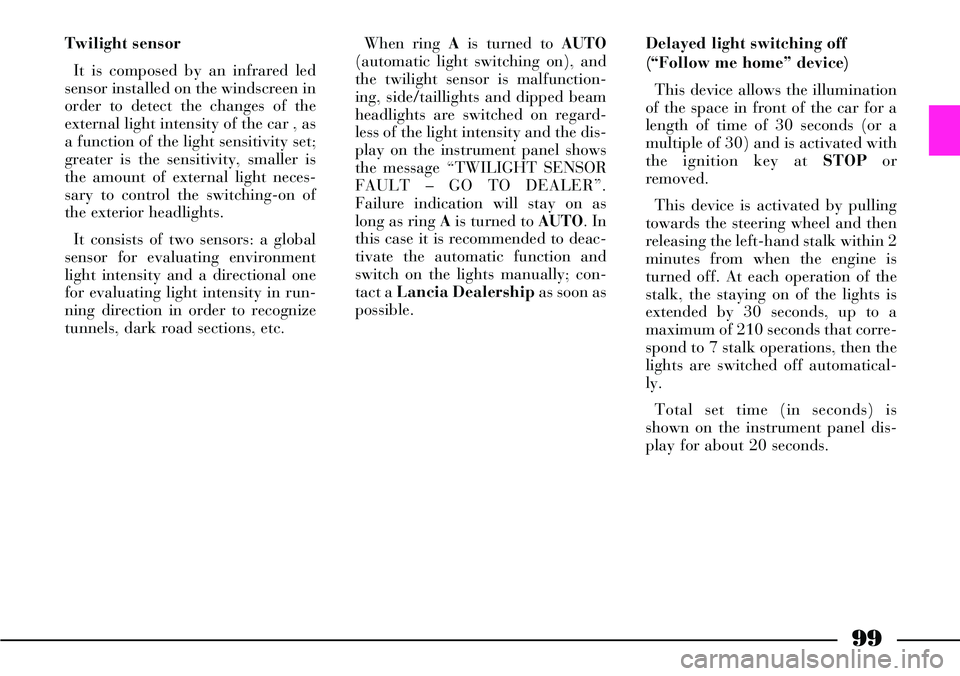
99
Twilight sensor
It is composed by an infrared led
sensor installed on the windscreen in
order to detect the changes of the
external light intensity of the car , as
a function of the light sensitivity set;
greater is the sensitivity, smaller is
the amount of external light neces-
sary to control the switching-on of
the exterior headlights.
It consists of two sensors: a global
sensor for evaluating environment
light intensity and a directional one
for evaluating light intensity in run-
ning direction in order to recognize
tunnels, dark road sections, etc.When ring Ais turned to AUTO
(automatic light switching on), and
the twilight sensor is malfunction-
ing, side/taillights and dipped beam
headlights are switched on regard-
less of the light intensity and the dis-
play on the instrument panel shows
the message “TWILIGHT SENSOR
FAULT – GO TO DEALER”.
Failure indication will stay on as
long as ring Ais turned to AUTO. In
this case it is recommended to deac-
tivate the automatic function and
switch on the lights manually; con-
tact a Lancia Dealershipas soon as
possible.Delayed light switching off
(“Follow me home” device)
This device allows the illumination
of the space in front of the car for a
length of time of 30 seconds (or a
multiple of 30) and is activated with
the ignition key at STOPor
removed.
This device is activated by pulling
towards the steering wheel and then
releasing the left-hand stalk within 2
minutes from when the engine is
turned off. At each operation of the
stalk, the staying on of the lights is
extended by 30 seconds, up to a
maximum of 210 seconds that corre-
spond to 7 stalk operations, then the
lights are switched off automatical-
ly.
Total set time (in seconds) is
shown on the instrument panel dis-
play for about 20 seconds.
Page 101 of 386
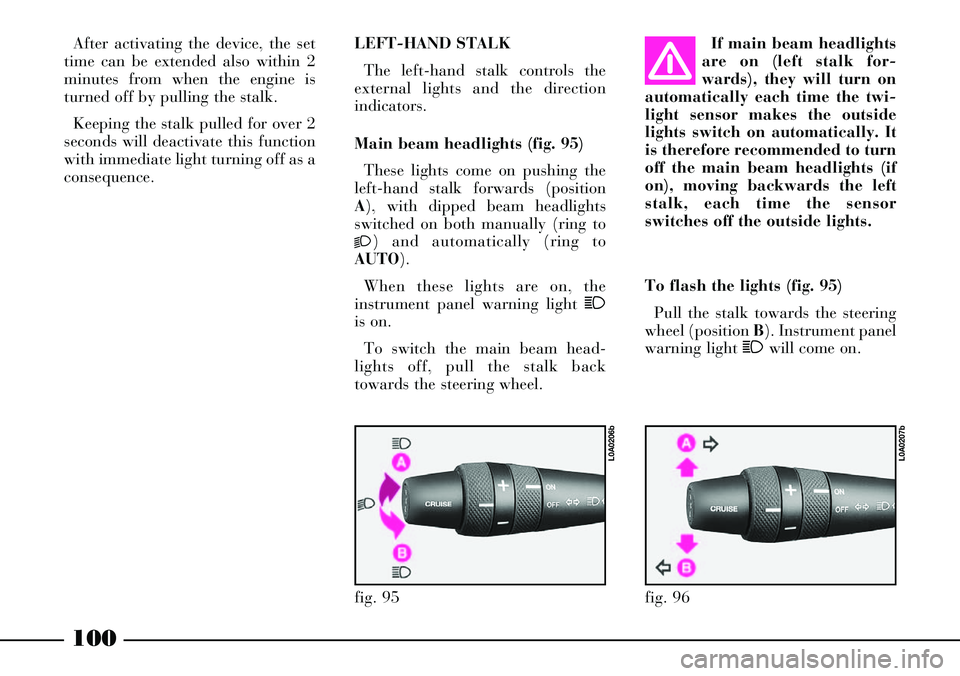
100
After activating the device, the set
time can be extended also within 2
minutes from when the engine is
turned off by pulling the stalk.
Keeping the stalk pulled for over 2
seconds will deactivate this function
with immediate light turning off as a
consequence.
To flash the lights (fig. 95)
Pull the stalk towards the steering
wheel (position B). Instrument panel
warning light 1will come on. LEFT-HAND STALK
The left-hand stalk controls the
external lights and the direction
indicators.
Main beam headlights (fig. 95)
These lights come on pushing the
left-hand stalk forwards (position
A), with dipped beam headlights
switched on both manually (ring to
2) and automatically (ring to
AUTO).
When these lights are on, the
instrument panel warning light 1
is on.
To switch the main beam head-
lights off, pull the stalk back
towards the steering wheel.If main beam headlights
are on (left stalk for-
wards), they will turn on
automatically each time the twi-
light sensor makes the outside
lights switch on automatically. It
is therefore recommended to turn
off the main beam headlights (if
on), moving backwards the left
stalk, each time the sensor
switches off the outside lights.
fig. 95
L0A0206b
fig. 96
L0A0207b
Page 103 of 386
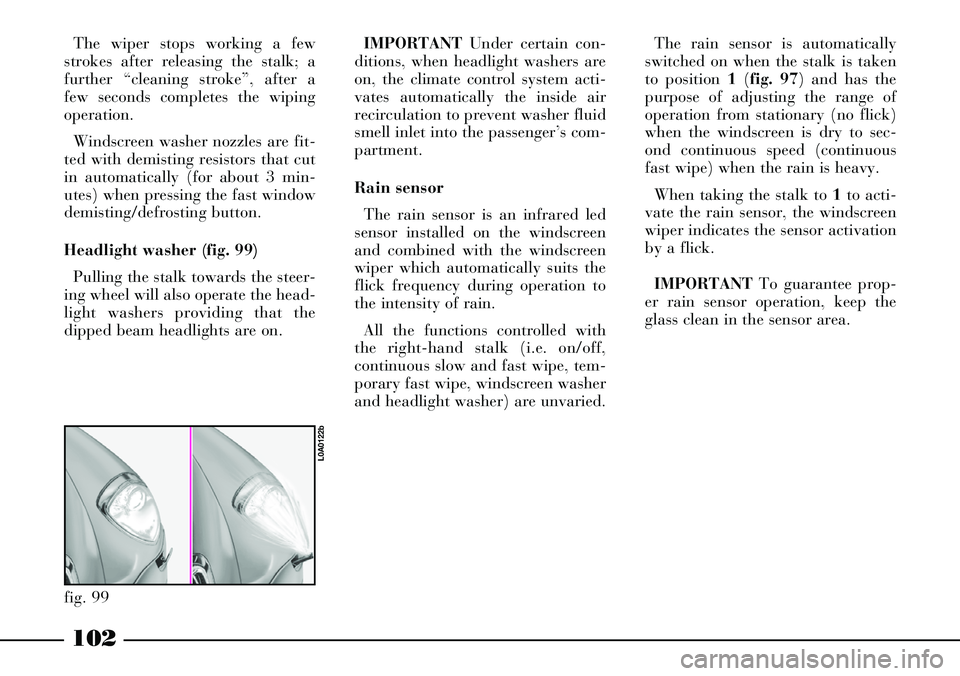
102
The wiper stops working a few
strokes after releasing the stalk; a
further “cleaning stroke”, after a
few seconds completes the wiping
operation.
Windscreen washer nozzles are fit-
ted with demisting resistors that cut
in automatically (for about 3 min-
utes) when pressing the fast window
demisting/defrosting button.
Headlight washer (fig. 99)
Pulling the stalk towards the steer-
ing wheel will also operate the head-
light washers providing that the
dipped beam headlights are on.IMPORTANTUnder certain con-
ditions, when headlight washers are
on, the climate control system acti-
vates automatically the inside air
recirculation to prevent washer fluid
smell inlet into the passenger’s com-
partment.
Rain sensor
The rain sensor is an infrared led
sensor installed on the windscreen
and combined with the windscreen
wiper which automatically suits the
flick frequency during operation to
the intensity of rain.
All the functions controlled with
the right-hand stalk (i.e. on/off,
continuous slow and fast wipe, tem-
porary fast wipe, windscreen washer
and headlight washer) are unvaried.
fig. 99
L0A0122b
The rain sensor is automatically
switched on when the stalk is taken
to position 1(fig. 97) and has the
purpose of adjusting the range of
operation from stationary (no flick)
when the windscreen is dry to sec-
ond continuous speed (continuous
fast wipe) when the rain is heavy.
When taking the stalk to 1to acti-
vate the rain sensor, the windscreen
wiper indicates the sensor activation
by a flick.
IMPORTANTTo guarantee prop-
er rain sensor operation, keep the
glass clean in the sensor area.
Page 104 of 386
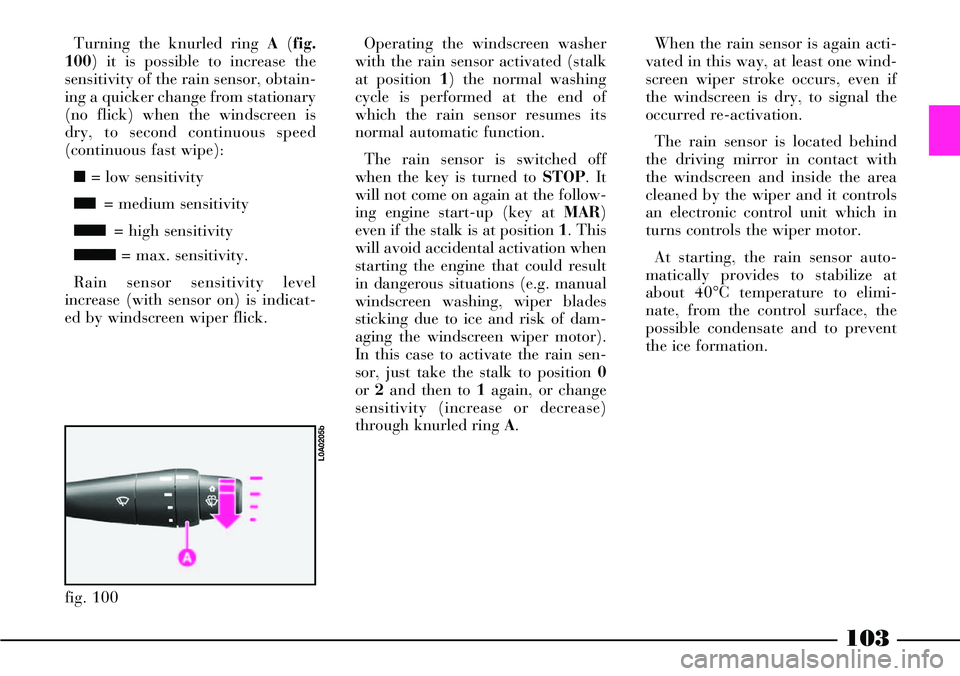
103
Operating the windscreen washer
with the rain sensor activated (stalk
at position 1) the normal washing
cycle is performed at the end of
which the rain sensor resumes its
normal automatic function.
The rain sensor is switched off
when the key is turned to STOP. It
will not come on again at the follow-
ing engine start-up (key at MAR)
even if the stalk is at position 1. This
will avoid accidental activation when
starting the engine that could result
in dangerous situations (e.g. manual
windscreen washing, wiper blades
sticking due to ice and risk of dam-
aging the windscreen wiper motor).
In this case to activate the rain sen-
sor, just take the stalk to position 0
or2and then to 1again, or change
sensitivity (increase or decrease)
through knurled ring A. When the rain sensor is again acti-
vated in this way, at least one wind-
screen wiper stroke occurs, even if
the windscreen is dry, to signal the
occurred re-activation.
The rain sensor is located behind
the driving mirror in contact with
the windscreen and inside the area
cleaned by the wiper and it controls
an electronic control unit which in
turns controls the wiper motor.
At starting, the rain sensor auto-
matically provides to stabilize at
about 40°C temperature to elimi-
nate, from the control surface, the
possible condensate and to prevent
the ice formation. Turning the knurled ring A(fig.
100) it is possible to increase the
sensitivity of the rain sensor, obtain-
ing a quicker change from stationary
(no flick) when the windscreen is
dry, to second continuous speed
(continuous fast wipe):
■= low sensitivity
■■= medium sensitivity
■■■= high sensitivity
■■■■= max. sensitivity.
Rain sensor sensitivity level
increase (with sensor on) is indicat-
ed by windscreen wiper flick.
fig. 100
L0A0205b
Page 105 of 386
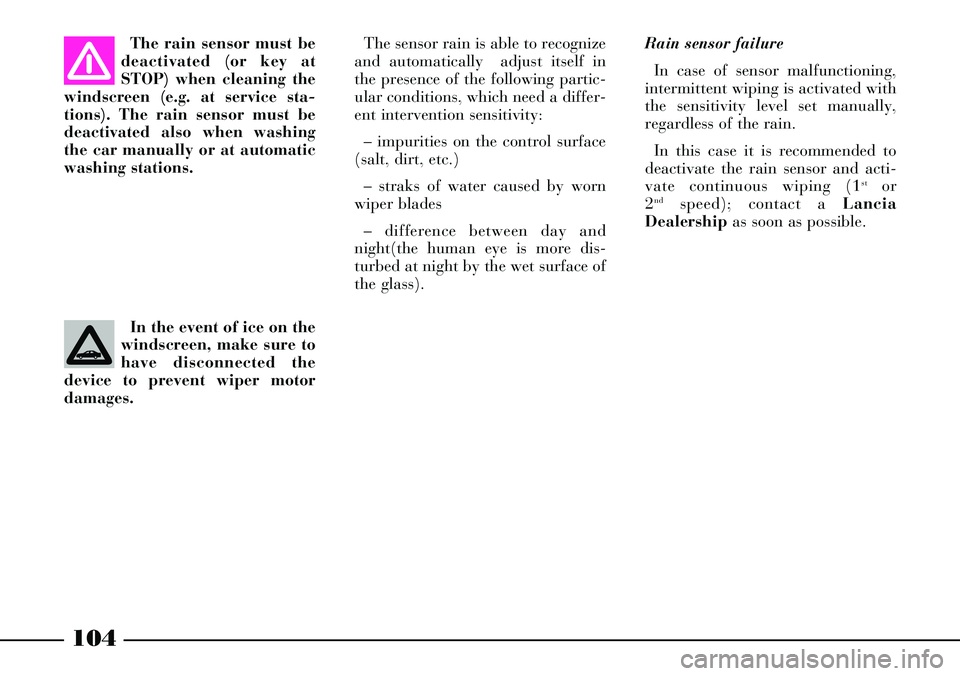
104
Rain sensor failure
In case of sensor malfunctioning,
intermittent wiping is activated with
the sensitivity level set manually,
regardless of the rain.
In this case it is recommended to
deactivate the rain sensor and acti-
vate continuous wiping (1
stor
2ndspeed); contact a Lancia
Dealership as soon as possible. The rain sensor must be
deactivated (or key at
STOP) when cleaning the
windscreen (e.g. at service sta-
tions). The rain sensor must be
deactivated also when washing
the car manually or at automatic
washing stations.
The sensor rain is able to recognize
and automatically adjust itself in
the presence of the following partic-
ular conditions, which need a differ-
ent intervention sensitivity:
– impurities on the control surface
(salt, dirt, etc.)
– straks of water caused by worn
wiper blades
– difference between day and
night(the human eye is more dis-
turbed at night by the wet surface of
the glass).
In the event of ice on the
windscreen, make sure to
have disconnected the
device to prevent wiper motor
damages.
Page 125 of 386

124
Bonnet and boot
Warning light/symbol
7
v
w
Message
BONNET OPEN
BOOT OPEN
BOOT AND BONNET OPENMeaning of the message
The engine bonnet is not
closed correctly
The boot is not
closed correctly
Engine bonnet and boot
are not closed correctlyAction
Close the engine
bonnet
Close the boot
tailgate
Close bonnet and boot
Window anti-trap safety system
Warning light/symbol
5
Message
WINDOW ANTI-TRAP
SYSTEM FAULT
FRONT LEFT
GO TO DEALER
WINDOW ANTI-TRAP
SYSTEM FAULT
FRONT RIGHT
GO TO DEALER
WINDOW ANTI-TRAP
SYSTEM FAULT
REAR LEFT
GO TO DEALER
WINDOW ANTI-TRAP
SYSTEM FAULT
REAR RIGHT
GO TO DEALERMeaning of the message
Front left-hand window
anti-trap system sensor
fault
Front right-hand window
anti-trap system sensor
fault
Rear left-hand window
anti-trap system sensor
fault
Rear right-hand window
anti-trap system sensor
failureAction
Contact a Lancia
Dealership
Contact a Lancia
Dealership
Contact a Lancia
Dealership
Contact a Lancia
Dealership
Page 128 of 386

Action
IMPORTANTIf the ¬warning light
does not turn on when turning the ig-
nition key to MARor if it stays on
when travelling, (together with mes-
sage on display) this could indicate a
failure in safety retaining systems; un-
der this condition air bags or preten-
sioners could not trigger in the event of
collision or, in a restricted number of
cases, they could trigger accidentally.
Stop the car and contact Lancia Deal-
ershipto have the system checked im-
mediately.
127
Outside temperature (ice hazard)
Warning light/symbol
❄
Message
WARNING ICE HAZARDMeaning of the message
Outside temperature is low
and there could be ice on the roadRemarks
Under certain conditions
(bridges, overbridges,
curves or road sections in
the shade, etc.) the air temperature
at ground level can be lower than
that at sensor level and therefore
there can be ice on the road
although this warning message is
not displayed
Message
AIRBAG SYSTEM
FAULT
AIRBAG SYSTEM
FAULT
SWITCH OFF ENGINE,
DO NOT PROCEEDMeaning of the message
Airbag system
failure
Airbag system
failure
Airbag
Warning light/symbol
¬
Page 133 of 386
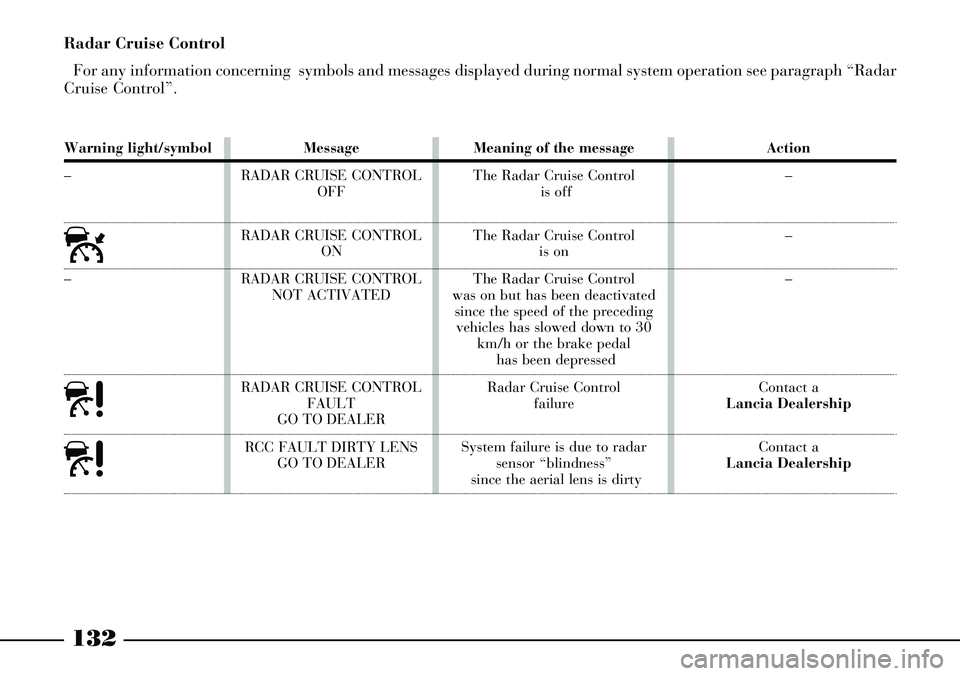
132
Warning light/symbol
–
ú
–
à
à
Message
RADAR CRUISE CONTROL
OFF
RADAR CRUISE CONTROL
ON
RADAR CRUISE CONTROL
NOT ACTIVATED
RADAR CRUISE CONTROL
FAULT
GO TO DEALER
RCC FAULT DIRTY LENS
GO TO DEALERMeaning of the message
The Radar Cruise Control
is off
The Radar Cruise Control
is on
The Radar Cruise Control
was on but has been deactivated
since the speed of the preceding
vehicles has slowed down to 30
km/h or the brake pedal
has been depressed
Radar Cruise Control
failure
System failure is due to radar
sensor “blindness”
since the aerial lens is dirtyAction
–
–
–
Contact a
Lancia Dealership
Contact a
Lancia Dealership
Radar Cruise Control
For any information concerning symbols and messages displayed during normal system operation see paragraph “Radar
Cruise Control”.
Page 136 of 386
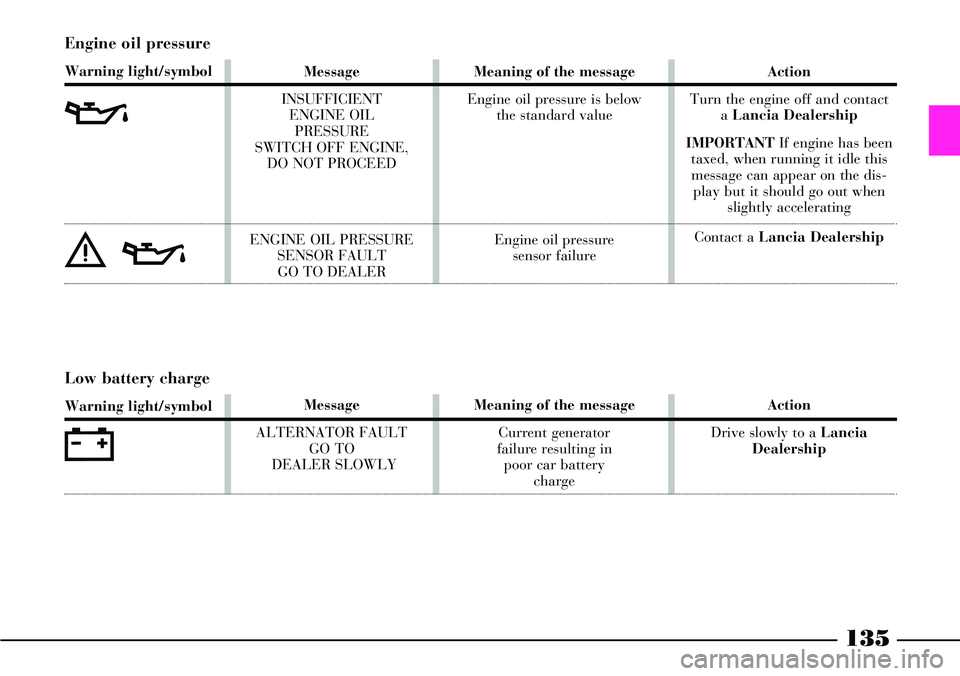
135
Engine oil pressure
Warning light/symbol
v
èv
Message
INSUFFICIENT
ENGINE OIL
PRESSURE
SWITCH OFF ENGINE,
DO NOT PROCEED
ENGINE OIL PRESSURE
SENSOR FAULT
GO TO DEALERMeaning of the message
Engine oil pressure is below
the standard value
Engine oil pressure
sensor failureAction
Turn the engine off and contact
a Lancia Dealership
IMPORTANTIf engine has been
taxed, when running it idle this
message can appear on the dis-
play but it should go out when
slightly accelerating
Contact a Lancia Dealership
Low battery charge
Warning light/symbol
w
Message
ALTERNATOR FAULT
GO TO
DEALER SLOWLYMeaning of the message
Current generator
failure resulting in
poor car battery
chargeAction
Drive slowly to a Lancia
Dealership
Page 137 of 386
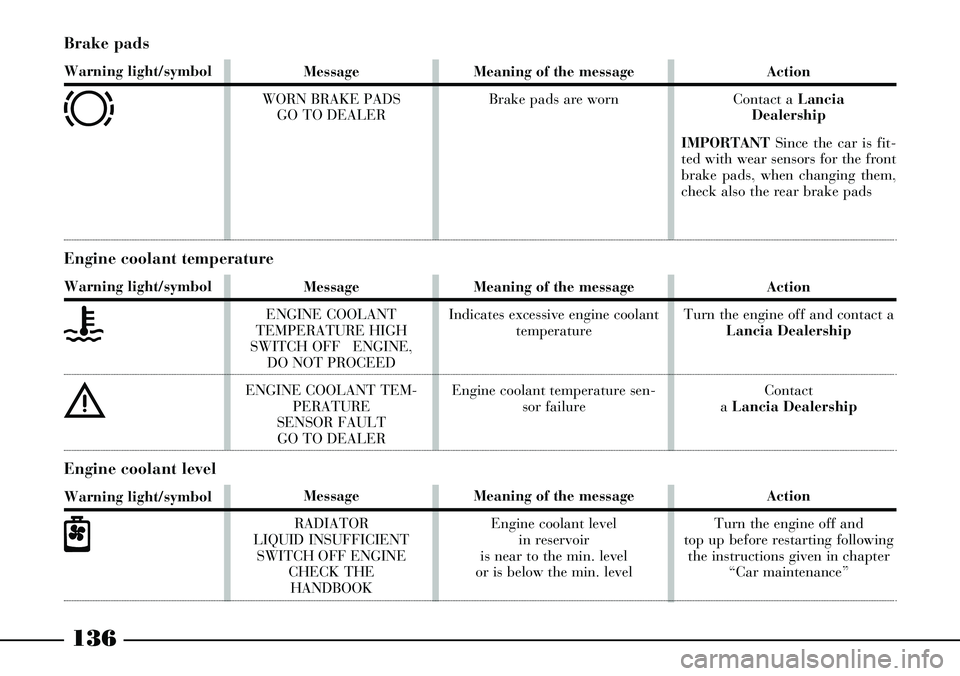
136
Brake pads
Warning light/symbol
d
Message
WORN BRAKE PADS
GO TO DEALERMeaning of the message
Brake pads are wornAction
Contact a Lancia
Dealership
IMPORTANT Since the car is fit-
ted with wear sensors for the front
brake pads, when changing them,
check also the rear brake pads
Engine coolant temperature
Warning light/symbol
u
è
Message
ENGINE COOLANT
TEMPERATURE HIGH
SWITCH OFF ENGINE,
DO NOT PROCEED
ENGINE COOLANT TEM-
PERATURE
SENSOR FAULT
GO TO DEALERMeaning of the message
Indicates excessive engine coolant
temperature
Engine coolant temperature sen-
sor failureAction
Turn the engine off and contact a
Lancia Dealership
Contact
a Lancia Dealership
Engine coolant level
Warning light/symbol
n
Message
RADIATOR
LIQUID INSUFFICIENT
SWITCH OFF ENGINE
CHECK THE
HANDBOOKMeaning of the message
Engine coolant level
in reservoir
is near to the min. level
or is below the min. levelAction
Turn the engine off and
top up before restarting following
the instructions given in chapter
“Car maintenance”